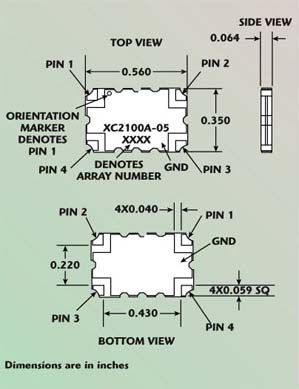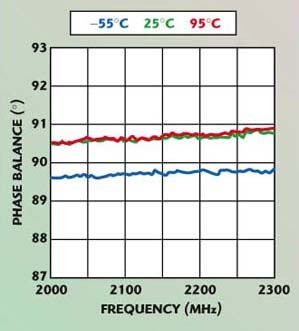A new family of low profile, high performance couplers has been introduced in a new easy-to-use, manufacturing friendly surface-mount package. These new couplers feature lower insertion loss, better phase balance, less amplitude imbalance, and higher isolation and directivity than previous offerings in this area. The new parts are much less frequency sensitive and feature considerably more power handling capability, as well as a higher maximum operating temperature. In addition, they are available in a lead free version, with larger pads for better solderability and larger gaps for more tolerant placement accuracy.
 | |||
| Fig. 1 XC2100A-05 mechanical outline. | |||
 | |||
| Fig. 2 XC2100A-05 unit’s coupling vs. frequency and temperature feeding port 1. | |||
 | |||
| Fig. 3 XC2100A-05 coupler’s phase balance vs. frequency and temperature feeding port 1. | |||
 | |||
| Fig. 4 XC2100A-05 coupler’s typical insertion loss feeding port 1. | |||
The Xinger® II family currently consists of 12 models and four different coupling values (3, 5, 10, 20) that are available in the popular 900, 1900 and 2100 MHz frequency bands. Each individual part is housed in a low profile surface-mount package that is 0.560" by 0.350" by approximately 0.064" thick. Figure 1 shows the physical outline of the 5 dB model XC2100A-05 coupler.
The new couplers are designed to cover the 2000 to 2300 MHz frequency range, except for the model XC1900A-10, which covers 1700 to 2000 MHz. However, other Xinger II models covering other frequency ranges and coupling factors are also available down to 800 MHz. A full list is available on the company Web site.
Individual Performance
The XC2100A-05 5 dB directional coupler operates from 2000 to 2300 MHz and features a mean coupling of 5.0 dB with an insertion loss of 0.15 dB max., a phase balance of 90° ±2.0° and a maximum VSWR of 1.15. Figure 2 shows the part’s coupling performance over its full operating frequency range at room temperature and the two extremes of its operating temperature specification of –55° to +95°C. Figure 3 shows its phase balance for similar conditions. Figure 4 shows its typical insertion loss.
This 5 dB directional coupler is primarily designed for UMTS and other applications, and is particularly useful for non-binary split and combine circuitry in high power amplifiers, plus other signal distribution applications where low insertion loss is required. These parts can be used in applications up to 175 W CW.
The model XC1900A-10 directional coupler features a 10.1 ±0.50 dB mean coupling from 1700 to 2000 MHz with an insertion loss of 0.16 dB max. and a directivity of 23 dB min. It features a maximum VSWR of 1.15 and can handle an average power of 175 W CW. This part is designed for the DCS and PCS frequency bands and is particularly applicable for power injection in feed-forward amplifier circuits where tightly controlled coupling and low insertion loss is required.
The model XC2100A-20 directional coupler has a mean coupling of 20.1 ±0.60 dB over its 2000 to 2300 MHz operating frequency range. It features an insertion loss of 0.15 dB max. and a directivity of 23 dB min. Its VSWR is 1.15 max. and average power capability is targeted at 150 W CW. This part is primarily designed for UMTS and other 3G applications for use in power and frequency detection and VSWR monitoring, where tightly controlled coupling and low insertion loss is required. It can be used in high power applications up to 150 W.
The model XC2100A-03 is a 3 dB, 90° hybrid coupler designed for the 2000 to 2300 MHz frequency range. Its isolation is 23 dB min. and insertion loss is 0.15 dB max. The hybrid coupler features a 90° ±2.0° phase shift and a maximum amplitude imbalance of ±0.15 dB, with a maximum power capability of 105 W (wideband). This unit is designed for UTMS and other 3G applications, particularly for balanced power and low noise amplifiers, as well as for signal distribution and other applications where low insertion loss and tight amplitude and phase balance are required. This part also can be used up to 150 W CW.
The new parts have been subjected to rigorous qualification testing and are manufactured using materials with coefficient of thermal expansions (CTE) compatible with common substrates such as FR-4, G-10, RF-35, RO4350 and polyimide. All parts are fully RF and DC tested for compliance to their performance specifications. Details of the test fixture used for performance testing can be found in the product data sheets supplied by the factory.
The Xinger II couplers are priced comparable to past Xinger parts and are available from stock. Additional information may be obtained from the company’s Web site.
Anaren Microwave Inc.,
E. Syracuse, NY
(315) 432-8909,
(800) 544-2414, www.anaren.com
